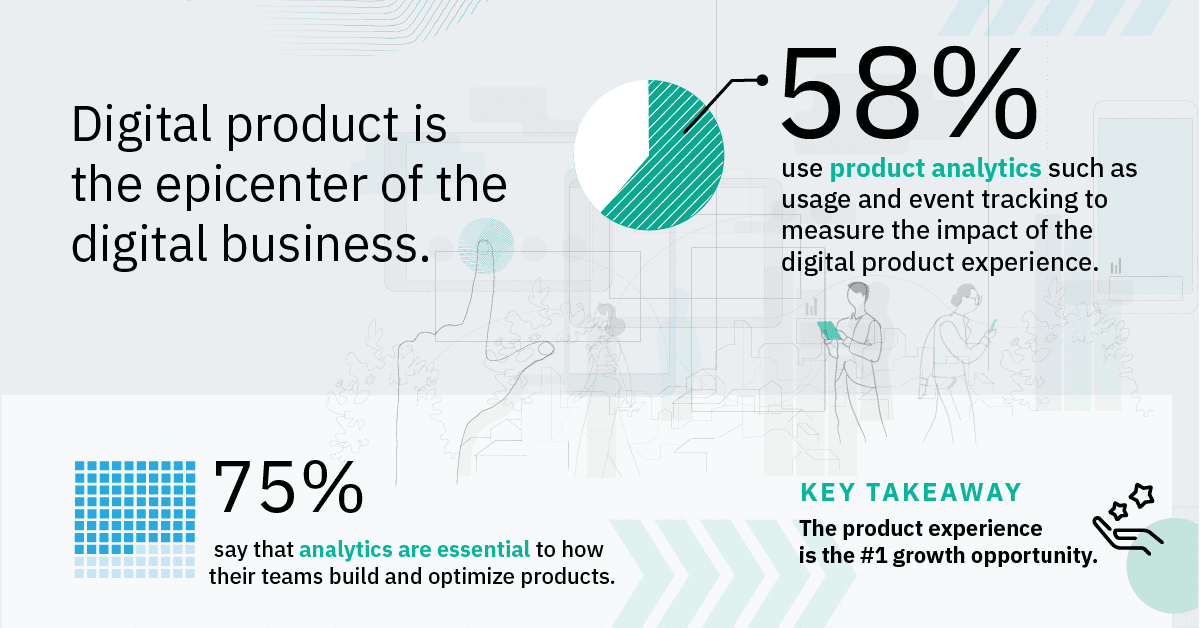Why Product Analytics is the New Standard for Digital Measurement
New research from Harvard Business Review Analytics Services sponsored by Amplitude reveals how companies like Ford, Match, and Care.com are using product analytics to place their digital bets to maximize revenue.
As a result of the pandemic, we’ve seen the entire world shift to digital everything.
This has had a tremendous impact on business, from rethinking budgets to developing new strategies. And the leaders who are taking a digital-first approach to customer experience, starting with product analytics, are delivering exceptional products and innovating faster than the competition.
After a six-month study in partnership with Harvard Business Review Analytics Services, we’re thrilled to share insights gathered from 295 leaders of digital businesses across the globe, including data from analyst firms Gartner and IDC and first-hand interviews with executives at Amplitude customers Ford, Match.com, Hubspot, and Care.com.
You can access a free copy of the Harvard Business Review report here–but we also wanted to take the opportunity to share the key findings of this new research.
The Digital-First Era Is Here to Stay

Digital products have long been redefining how we work, play, learn, connect, buy, and so much more. As a result of the pandemic, we saw the entire world shift their lives to digital-everything. Commutes were traded in for video calls, online delivery reached new highs, and going to the movies was replaced with direct to streaming options.
While this shift to digital was sudden, it also served as a catalyst for lasting and permanent changes across customer behavior and expectations, which in turn has created a new urgency around digital businesses everywhere. Effectively, the digital bar has been raised. Where digital was previously regarded as a new sales channel, it is now the primary business model. Going digital-first is no longer just about website analytics and digital ad campaigns. To truly be a digital-first company requires measuring every aspect of your customer interactions—especially within the product itself, with product analytics.
Making Insights Accessible to All with Product Analytics
There has been a dramatic shift in how teams ask and answer questions—with the ultimate goals of speeding up time to insight and better empathizing with digital customers.
What the Harvard Business Review Analytics Services research confirmed is that cross-functional teams are reaching a new level of insight into their digital business that they couldn’t get through legacy analytics tools, whether those were website analytics, surveys, or business intelligence tools that require an army of analysts and data scientists.
Digital organizations need to have self-service access to key digital metrics, but also need to explore data and answer strategic growth questions unique to digital product, marketing and customer-facing teams.

For example, Net Promoter Score (NPS) used to be the standard in measuring customer sentiment and loyalty. Now, only 16% of executives see customer sentiment scores such as NPS as important to a digital product’s long-term success. Instead, most executives see real-time user engagement within the digital product as the most important success factor.
Product analytics topped the list for solutions that solve this critical need. While online surveys are an effective way to measure sentiment over time or gather feedback to help guide physical product development (for example, what features do consumers like best for a new athletic shoe), surveys and other analytics tools were not built for the requirements of digital. To truly understand the digital customer journey requires a broad and deep understanding of every action a customer takes within the digital product, how individual actions correlate to value and revenue, and how product and marketing teams adapt digital experiences in real-time. You can only get this level of breadth and depth into the digital customer and digital product through product analytics.
Meet the Moment: Disrupt or be Digitally Disrupted

There are now two types of companies emerging faster than ever—digital disruptors and those being digitally disrupted—and this report identifies best practices for organizations looking to meet the moment in this new digital-first era. Key highlights include:
- User engagement is the number one indicator of a digital product’s long-term success. Companies need to shift to measuring how customers are realizing value within their digital products, not just on their websites.
- Net Promoter Score (NPS) is fading in relevance. Only 16% of executives viewed customer sentiment as crucial to a product’s long-term success. A more core measurement: real-time engagement with the product.
- A data-centric culture is essential for integrating data from multiple sources, which is needed to produce a truly well-rounded, cross-functional picture of customer engagement and experience.
At Amplitude, we’ve seen the impact of putting customer insights at the heart of digital-first businesses. With Harvard Business Review Analytics Services, we examined the shift in customers’ digital behaviors and expectations to uncover how businesses can thoughtfully transition to digital-first. We invite you to download the full report to explore the opportunity businesses have to overcome their data challenges, gain competitive edge, and improve customer loyalty in the digital-first era.

JJ Johnson
Former Chief Marketing & Strategy Officer, Amplitude
Jennifer Johnson (JJ) formerly led the global marketing, partnerships and customer experience organizations. Prior to Amplitude, JJ was CMO at Tenable and was instrumental in its 2018 IPO. JJ was also CMO at Tanium and Coverity (now Synopsys), and a Partner at Andreessen Horowitz.
More from JJ





